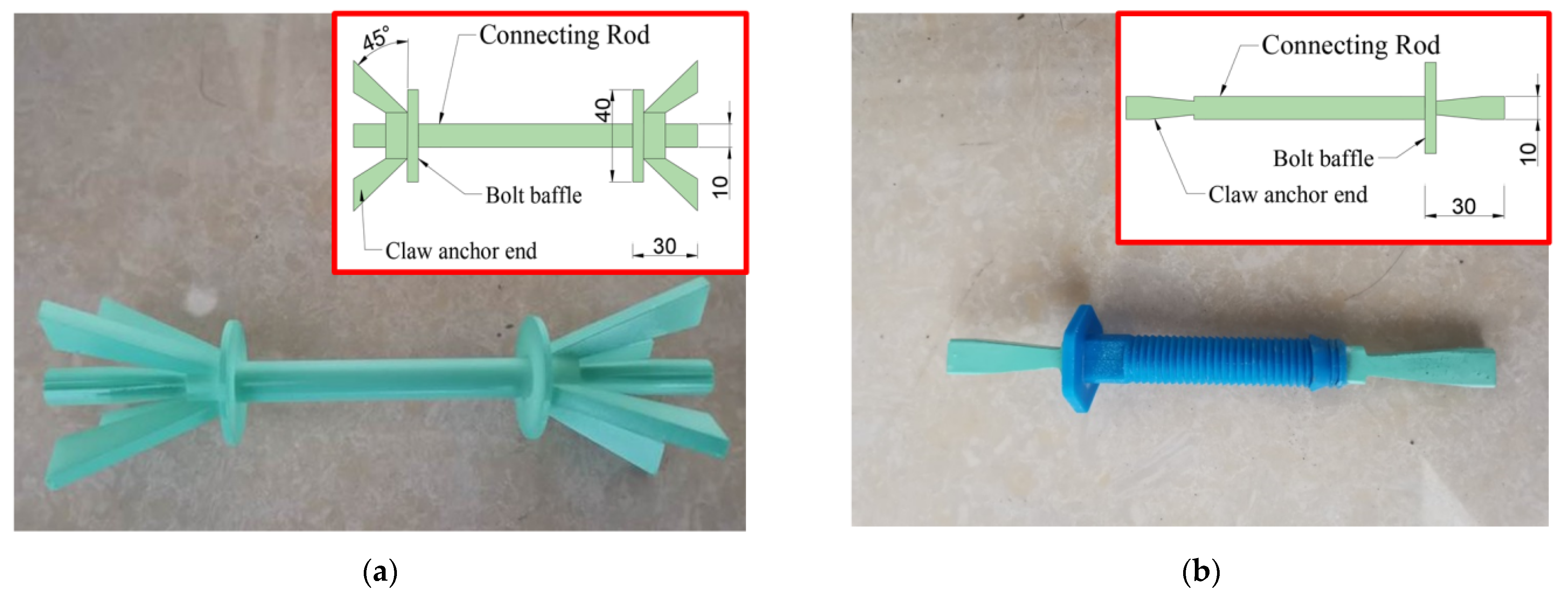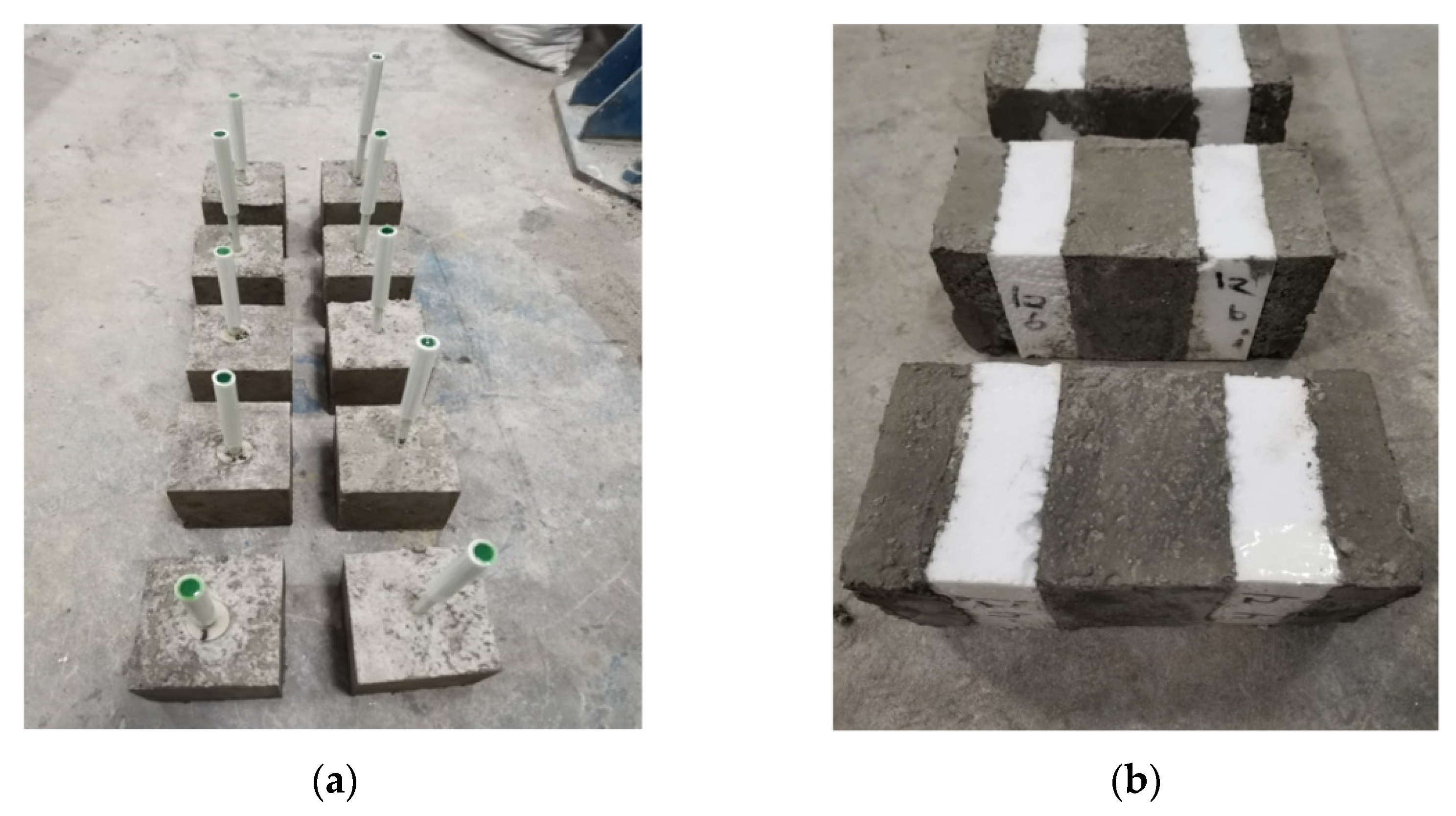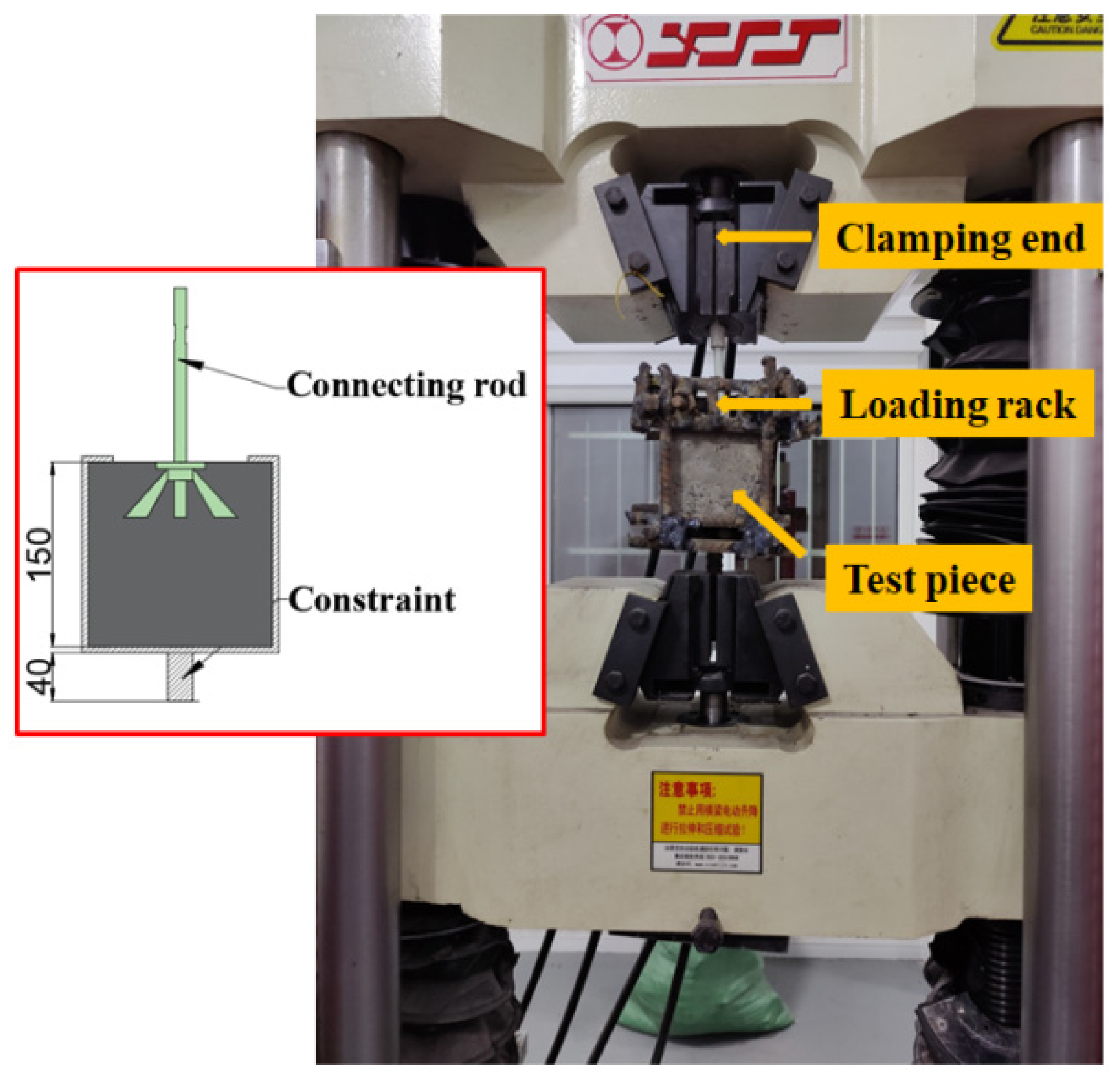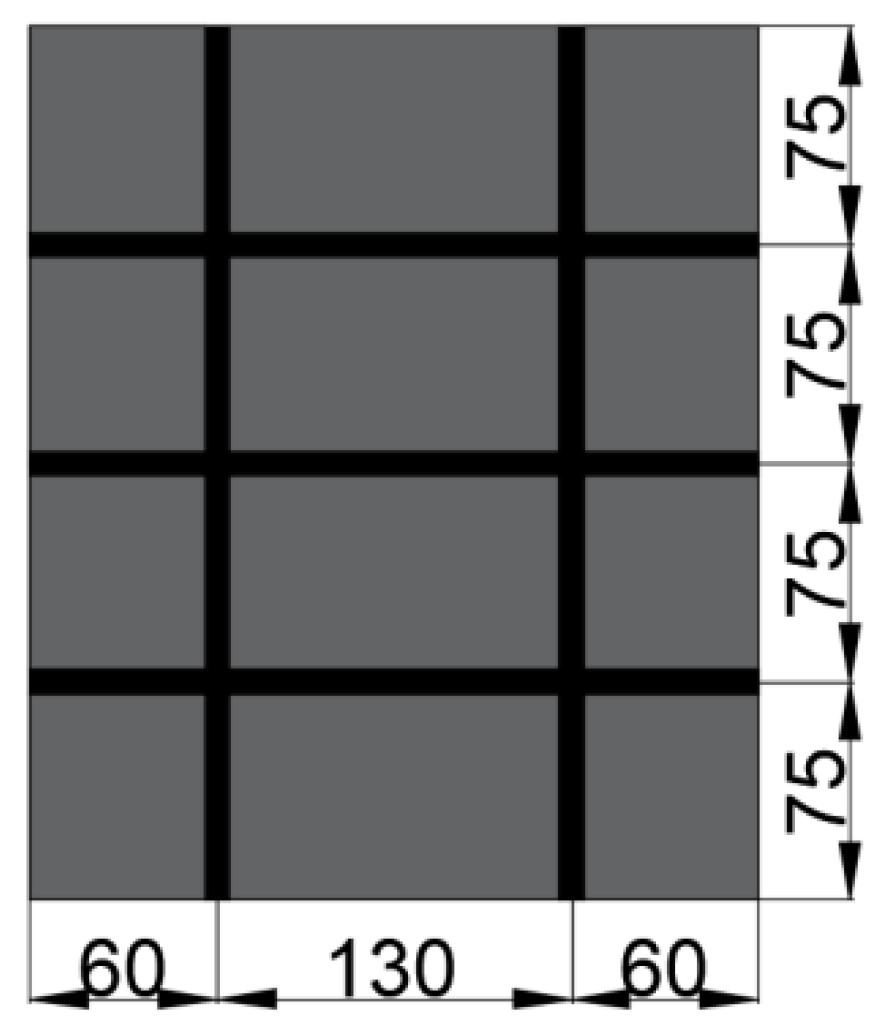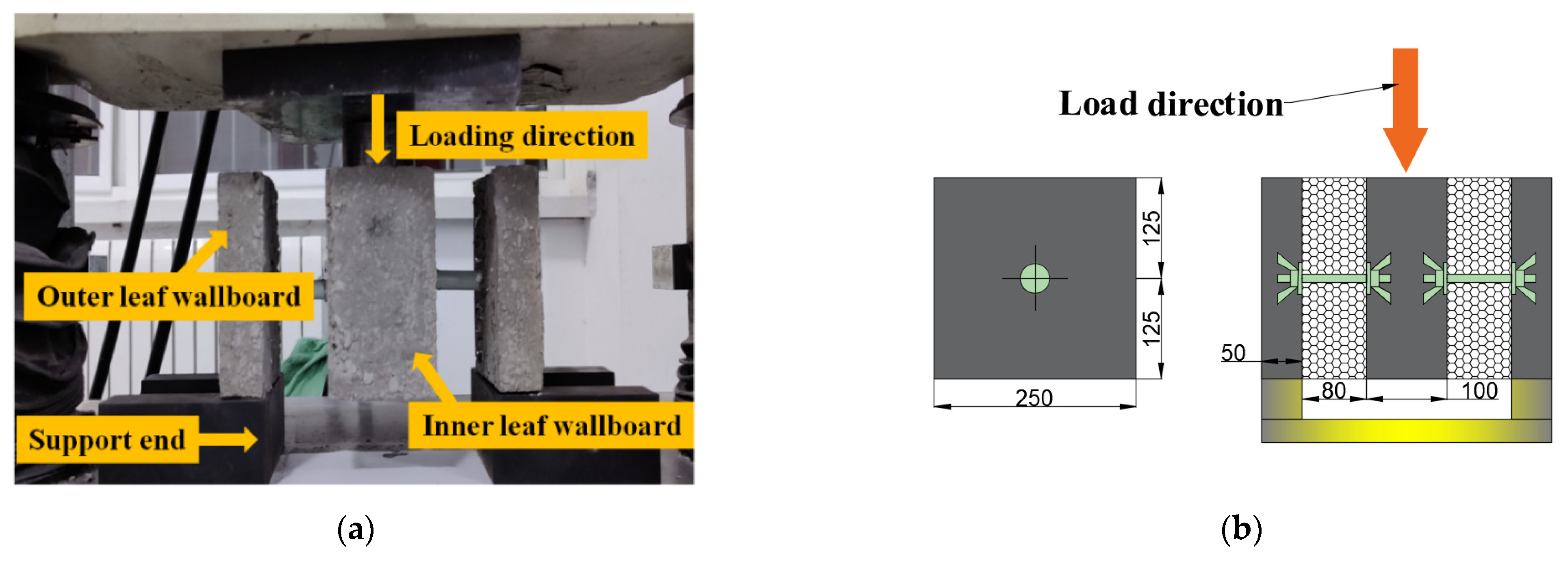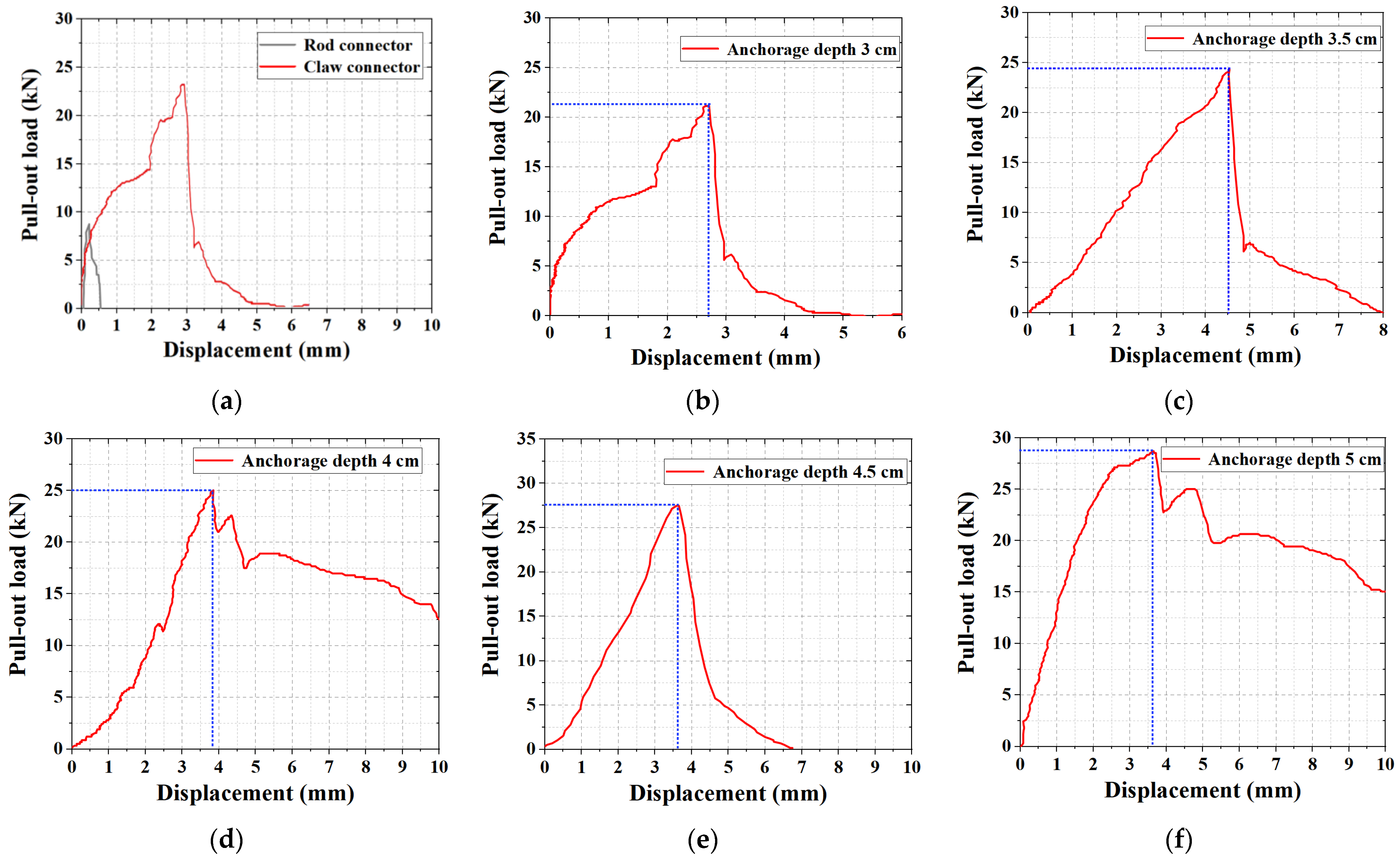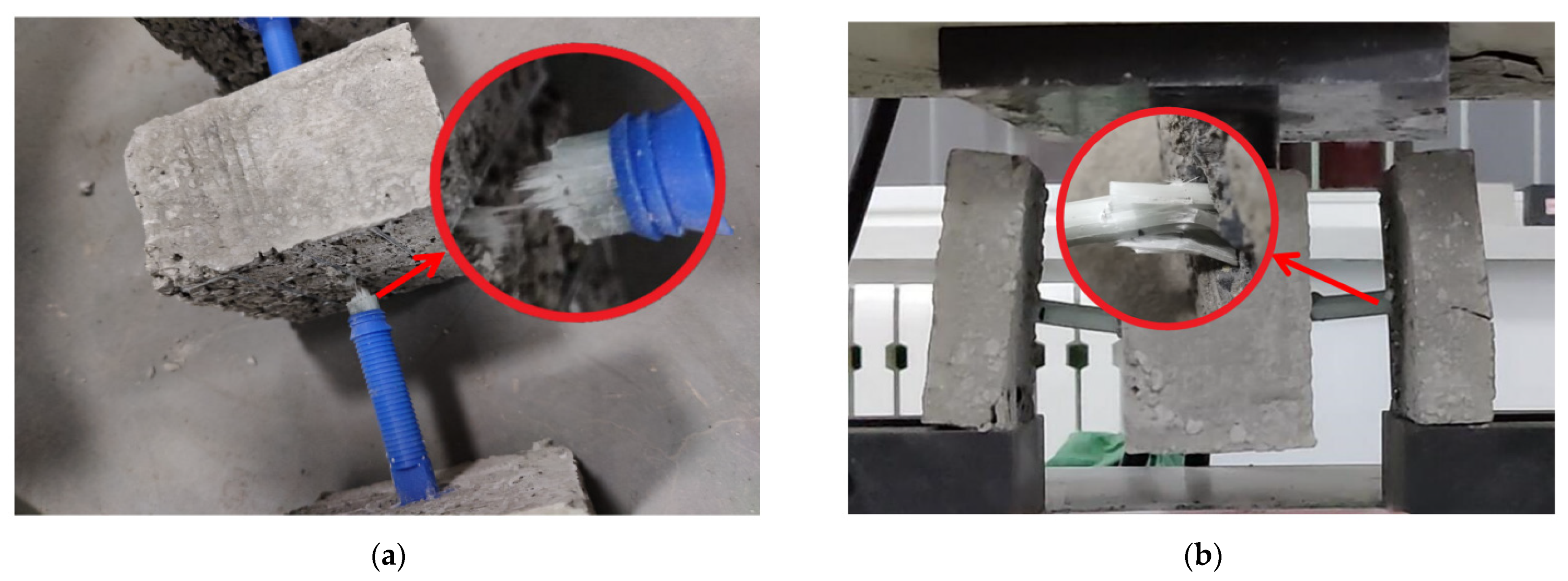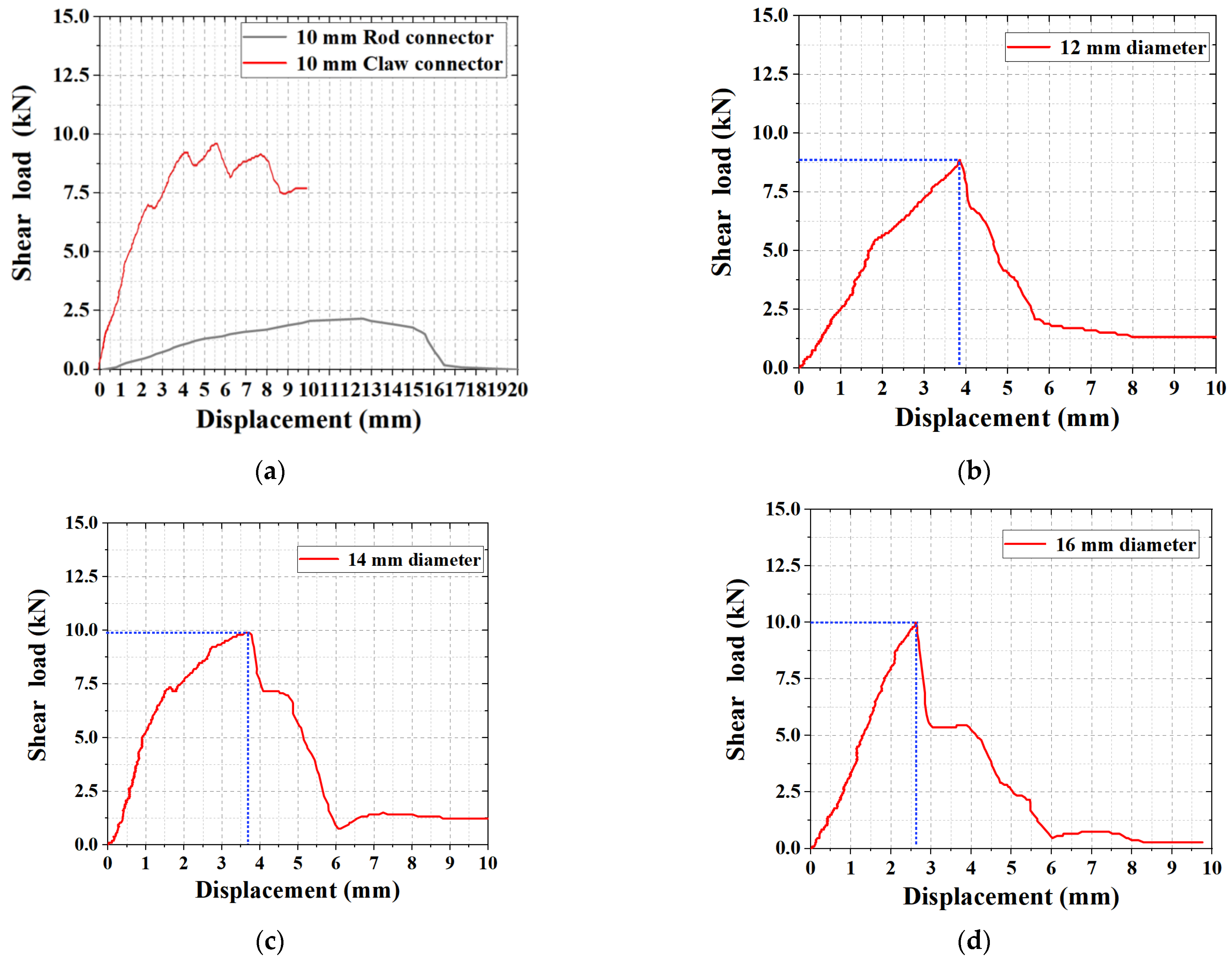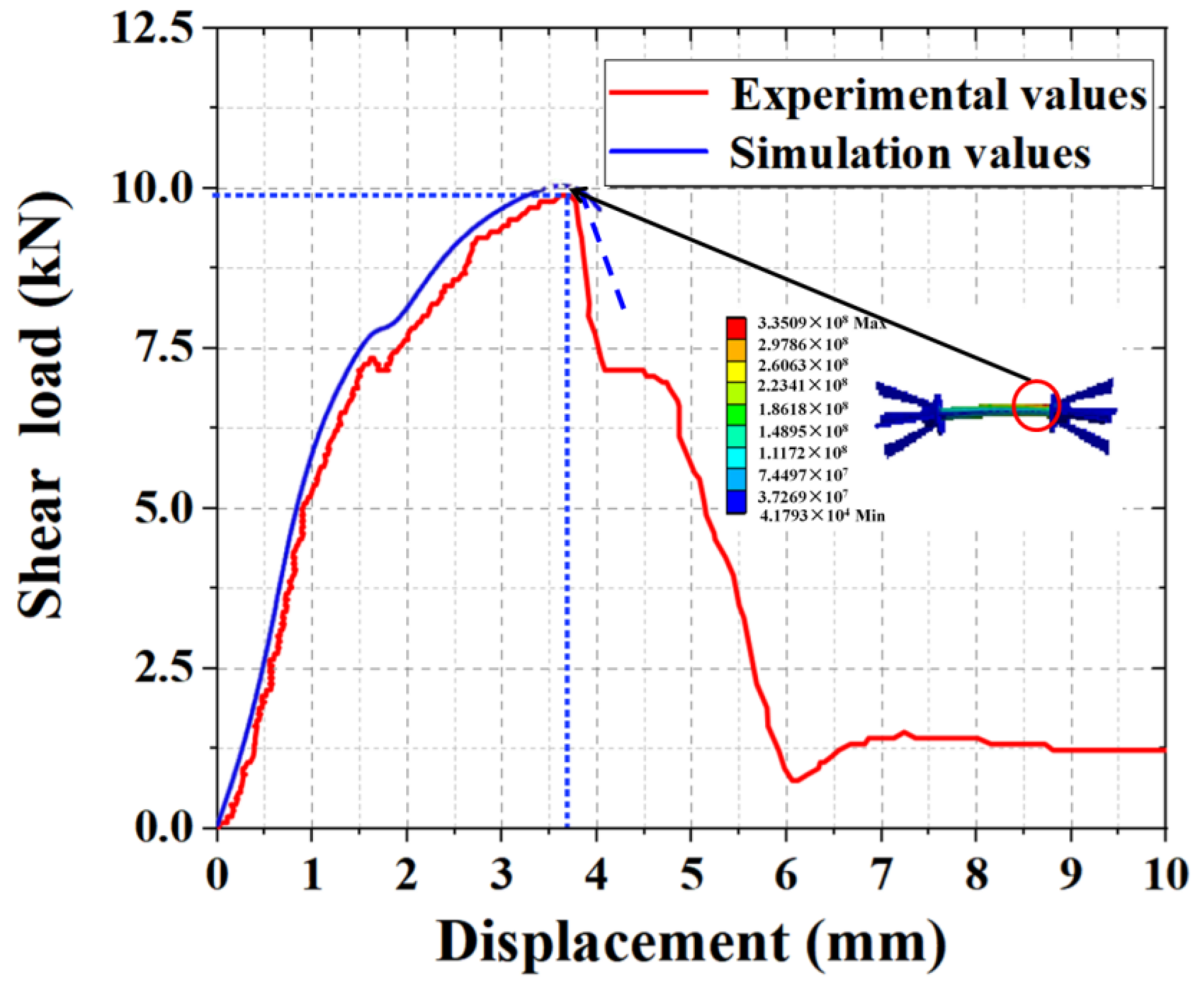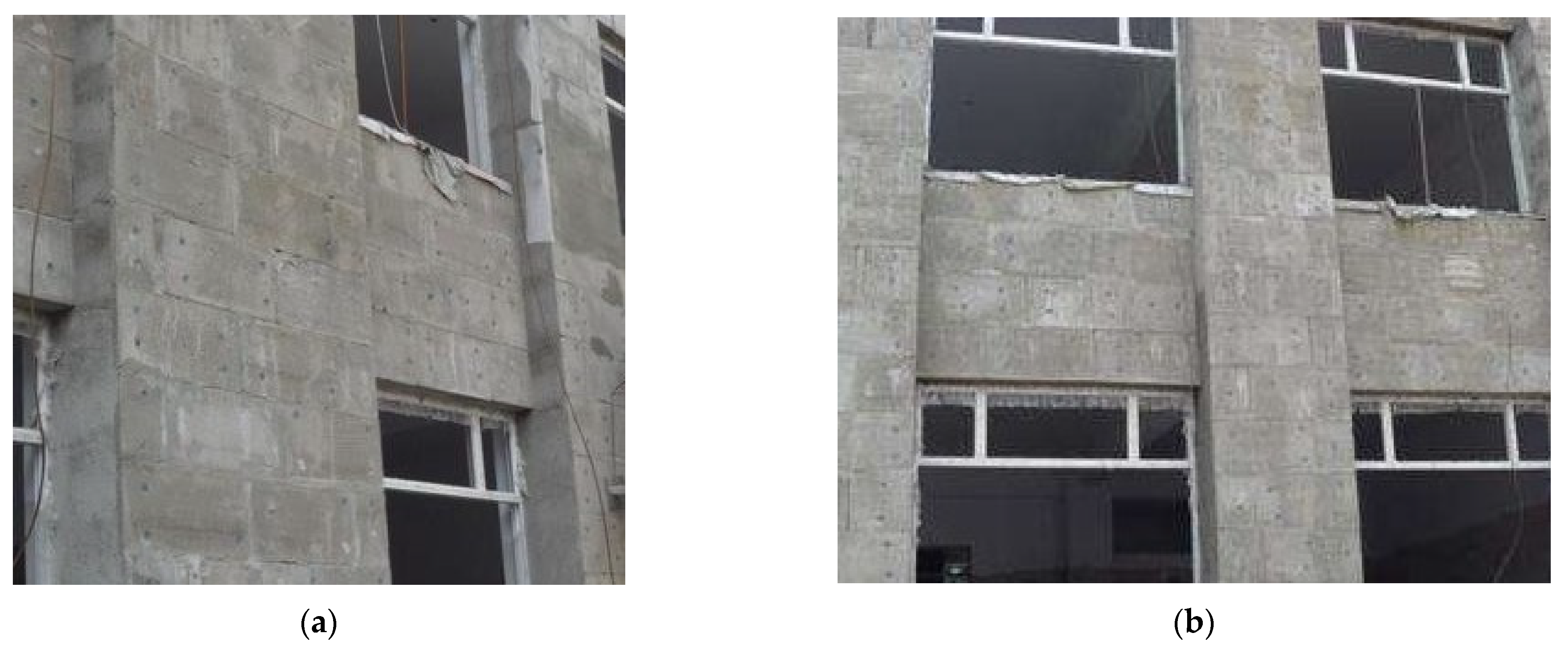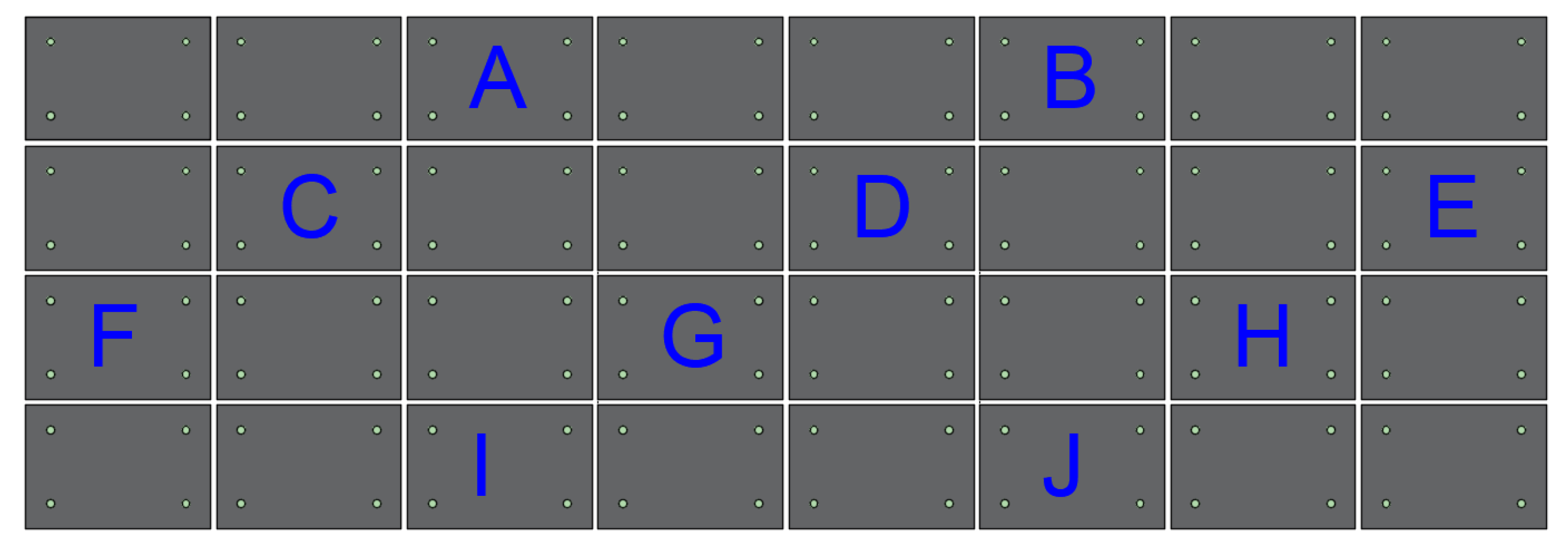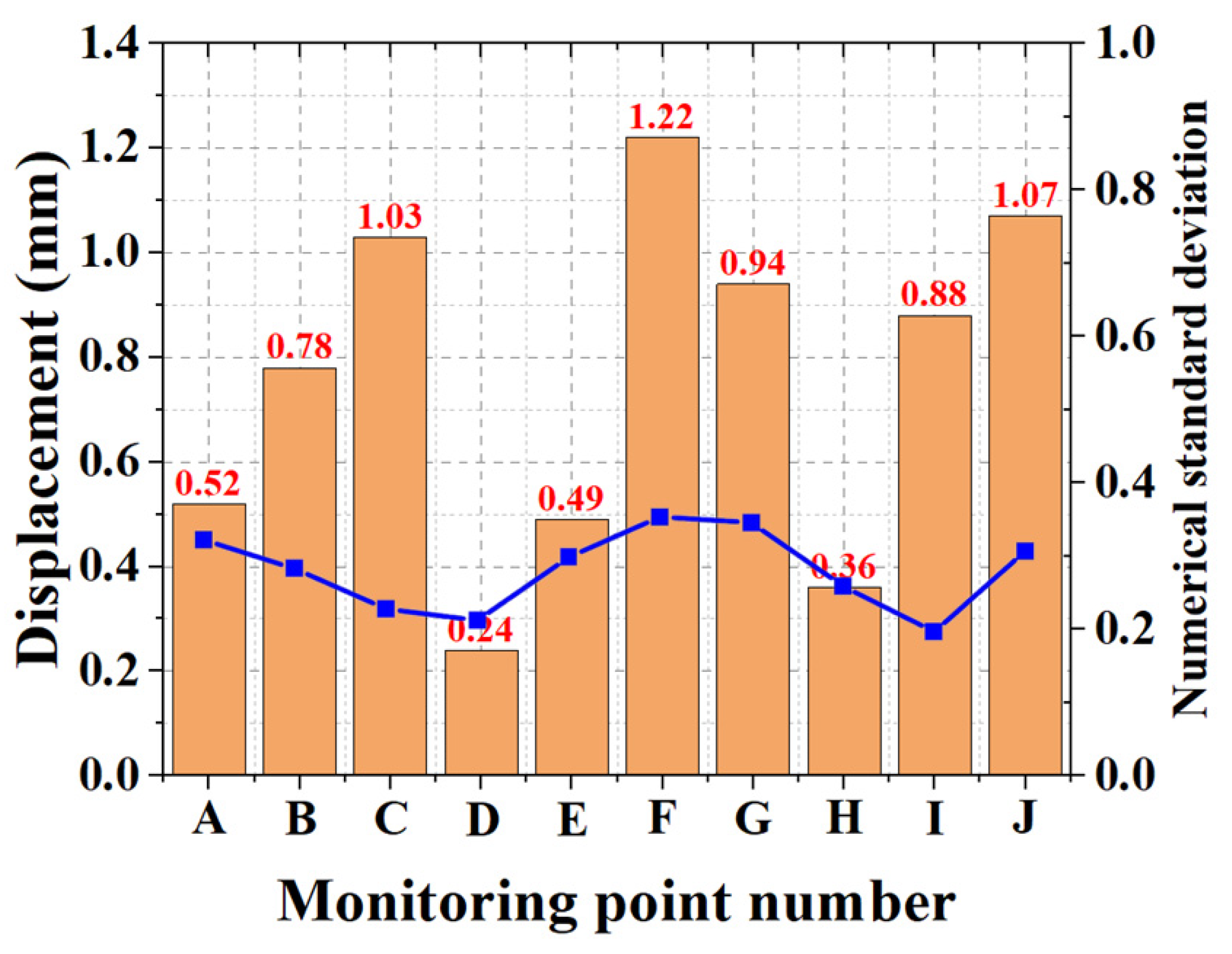1. Introduction
Assembled buildings are representative of modern industrialized production methods that are being vigorously promoted and applied in China because of their advantages of safe construction, high efficiency, high quality, energy savings, and environmental protection. Connections are important tools in the installation of assembled buildings and are the core components that ensure the reliability of the assembled-building connections. Insulated concrete sandwich-wall-panel (ICSWP) connectors are an integral part of assembled-building connectors; hence, mastering their engineering characteristics is key to ensuring the quality of insulated sandwich-wall-panel installations.
Domestic and foreign researchers have conducted several studies on the structural materials of connectors. Zhang et al. [
1] studied the mechanical properties of stainless-steel joist connectors and demonstrated their shear resistance. Kang et al. [
2] studied and calculated the thermal-bridging coefficients of steel, aluminum, and stainless-steel material joints, and the results showed that the metallic-material joints did not meet the thermal-insulation criteria in most cases. Greg et al. [
3] confirmed the excellent overall performance of fiber-reinforced-plastic (FRP) connections, which was superior to that of conventional steel and polymer materials. Jiang et al. [
4] evaluated the shear performance of steel-fiber-reinforced polymeric-material joints. Zhihua et al. [
5] proposed an empirical formula for predicting the shear strength of glass-fiber-reinforced-plastic (GFRP) open joints through experimental and finite-element parametric analyses. Clay et al. [
6] studied the mechanical properties of different materials, such as glass-fiber-composite reinforcement, stainless steel, galvanized steel, basalt-fiber cloth, and carbon-fiber cloth, to quantify their failure modes and shear resistance. The results indicated that the performance of joints made of FRP materials was outstanding. Prabhu et al. [
7] analyzed the tensile and interlaminar shear properties of hybrid Agave sisalana and glass fiber-reinforced polyester composites, and Zhizhou et al. [
8] proposed a new I-shaped FRP-material connector for insulated, precast, concrete sandwich-wall panels (IPCSWPs) and performed quasi-static in-plane shear tests to measure the performance of the connector. Pan et al. [
9] proposed a C-shaped GFRP connector and quantified its performance under different loading conditions using shear, tensile, and compression tests to derive equations to predict the damage pattern of the connector system. He et al. [
10] designed a new type of GFRP I-shaped joint, proposed a new anchorage form with the insertion of anchor reinforcement at the end, and established a punching- and cutting-damage surface-determination method and bearing-capacity formula. Zheng et al. [
11] studied the engineering characteristics of rod-shaped, plate-shaped, L-shaped, H-shaped, and slotted joints, and the results indicated that slotted joints are more suitable as internal joints of insulated sandwich walls. Qing et al. [
12] proposed a cross-shaped GFRP-material tie member and investigated the effects of its cross-sectional area and arrangement on the engineering properties. Huang [
13] conducted shear tests on three types of GFRP connectors, namely, flat plates, corrugated plates, and hexagonal tubes, to re-evaluate the performance of the connectors. Zhang et al. [
14] studied the compressive properties of concrete filled with different GFRP tubes, and Eskenati et al. [
15] carried out experimental and numerical studies on the mechanical properties of GFRP-type-I connectors.
To examine the performance of connectors, researchers have also conducted extensive research using several research methods. Garai et al. [
16,
17] proposed a microstructure–mechanical research method for glass composites. Jiang et al. [
18] developed a finite-element model using ABAQUS and used the variable-parameter-analysis method to analyze the combined properties of GFRP-material ties. Insub et al. [
19] experimentally investigated the fatigue resistance of ICSWPs, and the results showed that fatigue loading significantly affected the load-carrying capacity of the joints. Shao et al. [
20] constructed an evaluation system for the pulling parts of ICSWPs using hierarchical analysis and verified the feasibility of the evaluation model. Shi et al. [
21] studied the mechanical properties of alkali-resistant glass fiber and concrete composite structures through experiments. Huang et al. [
22] conducted static-bending tests and concluded that the stiffness combination of sandwich plates has a tendency to grow nonlinearly with the increase in the shear stiffness of GFRP shear connectors. Won-Hee et al. [
23] developed a design model for GFRP mesh sandwich-wall panels to resist bending damage by considering the ultimate and normal-use states. Hou et al. [
24] investigated the flexural performance of four types of GFRP connectors: diagonal, round-hole, slotted-hole, and solid webs. The results showed that dense-web GFRP connectors had a high ultimate flexural strength. Lochan et al. [
25] proposed a method to investigate the tensile strength of GFRP materials by bending experiments and obtained a correlation between the fracture modulus and tensile strength of GFRP bars. Wu et al. [
26] studied the effects of different parameters on the bonding of GFRP materials with concrete. Wu et al. [
27] studied the long-term durability of GFRP materials in different environments and established a tensile-strength-prediction model for GFRP bars.
Thus, a large number of studies have been conducted on different materials and structures of connectors and their engineering properties, which provide methodological references and ideas for this study. However, materials with superior performance are not usually adopted, research on multi-directional shear connectors is still not abundant, and some connectors still have the problems of insufficient anchorage force and a complicated prefabricated construction process. Therefore, it is necessary to investigate the engineering properties of novel structural joints made of alkali-resistant glass-fiber materials (FGFRPs).
To solve the problems of complicated prefabricated construction, insufficient anchoring force, and durability of existing connectors, a new claw connector made of FGFRP is designed in this paper based on rod connectors. Although the mechanical properties of the rod connector in the shear direction are isotropic, this is not required in the prefabrication process of the insulated sandwich-wall plate-composite structure of the connector, which simplifies the construction complexity. There are four extended claws at the anchorage ends of the connector, which improve its anchorage strength. Additionally, the connector is made of FGFRP, which significantly improves the overall durability.
The engineering characteristics of the connection were investigated, and numerical simulations were performed using ANSYS finite-element software to analyze the stress–strain of the combined structure of the joints under different stress conditions as well as the failure modes of the structure. The products were verified and applied in the Shennong Zhigu-Time Cloud project in Tai’an City, China, and it had a good performance, thereby providing an important reference for similar projects.
4. Numerical Simulation
A numerical model was constructed for the new connector described in
Section 2. The optimal anchorage depth and external diameter of the connector were 3.5 cm and 14 mm, respectively. To further analyze the mechanical properties of the optimal connector structure, the external diameter of the connector was 14 mm, and the anchorage depth was 3.5 cm in the numerical model. To simulate the force characteristics of the model, an insulated wall panel was considered as the object of study. Constraints were applied to the inner-leaf wall panels of the insulated wall, and different sizes of concentrated loads were applied to the outer-leaf wall panels during the simulation with vertical and horizontal load directions. The theoretical analysis showed that applying a unilateral shear force to the outer-leaf wall panel had the same shear effect as the experimental loading.
Figure 12 shows the details of the model.
LINK8 units were used for the connection and SOLID65 units were used for the concrete. The Poisson’s ratio V of the concrete was chosen to be 0.3, and the values of the remaining parameters are listed in
Table 8. In the finite-element analysis, the function of the large deformation of concrete was turned on. The Poisson ratio V of the FGFRP material was considered as 0.38, and the rest of the parameters are listed in
Table 1.
Ft is the tensile strength, Fc is the compressive strength, ψ is the expansion angle, fb0/fc0 is the ratio of the biaxial ultimate compressive strength to the uniaxial compressive ultimate strength, Kc is the ratio of the second stress invariance on the tensile radial plane to that on the compressive radial plane, and µ is the viscosity coefficient.
4.1. Comparative Analysis of the Experimental and Simulated Pull-Out Results
As shown in
Figure 13, the pull-out simulation curve had the same variation pattern as the experimental curve at the preloading period and had a good fit. The experimental ultimate tensile strength was 24.33 kN, whereas the experimental simulated tensile strength was 23.13 kN, and the simulated value was 95.10% of the experimental value, with a deviation of 4.9%. In a similar study, Huang et al. [
13] compared the numerical simulation results with the experimental results, and the average Pf and limit Kf deviations were 6.0% and 8.5%, respectively. Furthermore, the data in this study showed that the simulated ultimate load value was slightly smaller than that of the experimental value because the small loading range increased owing to the weight of the experimental specimen during the experiment, and the viscosity coefficient of concrete changed over a small range owing to the influence of humidity during the experiment. However, the model accurately predicted the experimental results in the load-increasing stage. As shown by the strain cloud diagram, the model exhibited the largest deformation at the anchorage position of the tensile end and was prone to damage. This was confirmed by the fracture of the anchor jaws during the experiment, which proved the correctness of the experimental results and the rationality of the numerical simulation.
4.2. Comparative Analysis of the Experimental and Simulated Shear Results
As shown in
Figure 14, in the preloading period, the shear simulation curve had the same variation pattern as the experimental curve, and the load increased sharply with an increase in displacement. When the load reached a certain value, the load–displacement curve appeared similar to the yield phenomenon and began to drop sharply when the load exceeded the limit value. The ultimate load of shear simulation was 10.14 kN, whereas the experimental ultimate value was 9.89 kN. The simulated value was 102.50% of the experimental value, with a deviation of 2.50%. In a similar study, Zhizhou et al. [
8] compared the numerical-simulation results with the experimental results and analyzed the reasons for the differences. The data in the study showed that the simulated ultimate load was slightly larger than the experimental value because the numerical simulation was completely idealized, and the concrete was affected by humidity, the displacement of the reinforcement position, and lack of vibration density during the experiment, resulting in a deviation between the experimental ultimate load and the simulation value. However, the model accurately predicted the experimental results in the load-increasing stage. As shown in the strain cloud diagram, the maximum strain was generated at the interface between the outer-leaf wall plate and connecting rod, which was consistent with the experimental damage results. Hence, the accuracy of the experimental results and reasonableness of the numerical simulation were confirmed.
